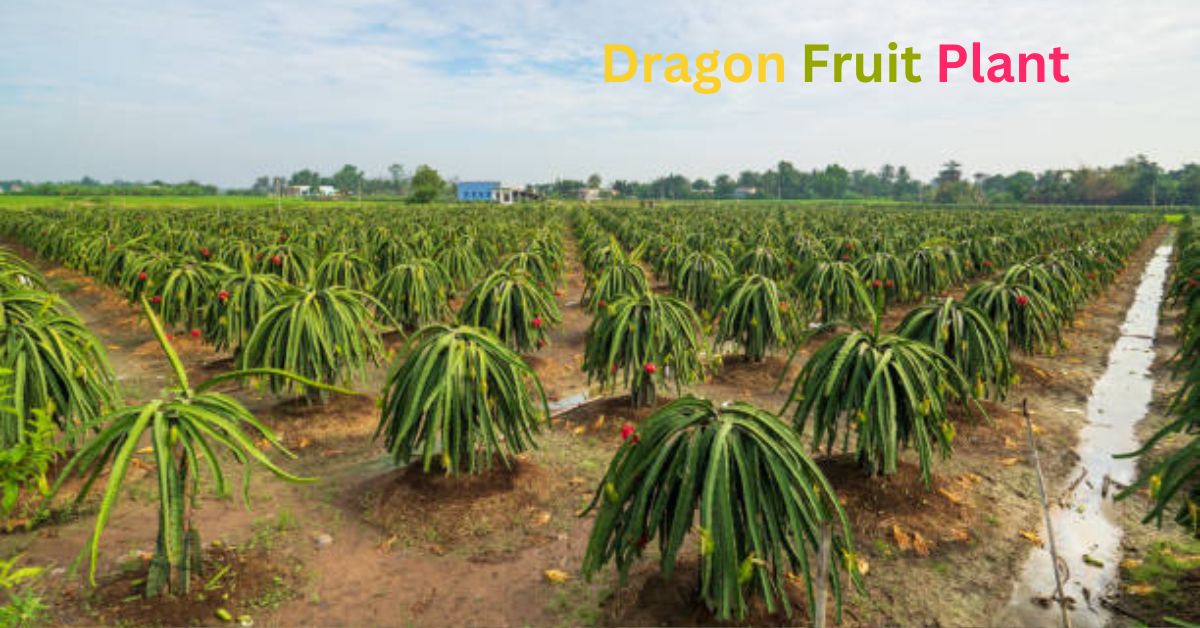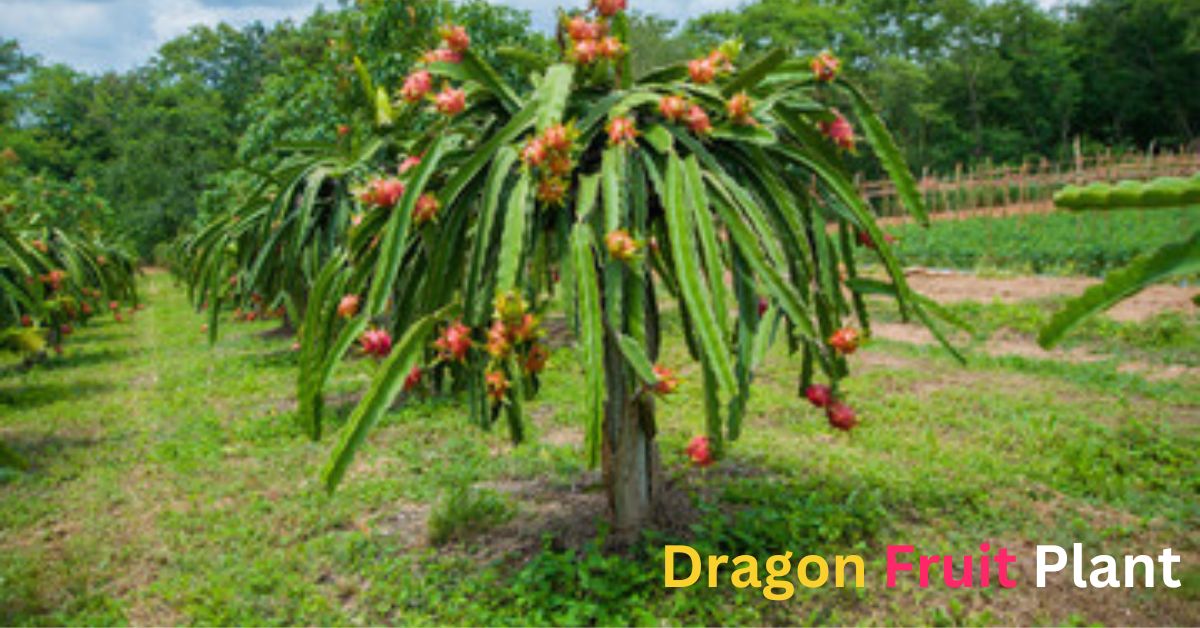Introduction
The dragon fruit plant, with its stunning appearance and exotic charm, is a true treasure among tropical plants. Originating from Central and South America, this remarkable cactus has found its way into gardens and farms across the globe, thriving in tropical and subtropical climates. Beloved for its vibrant fruit and potential health benefits, the dragon fruit plant is as fascinating as it is rewarding to grow.
Types of Dragon Fruit Plants
Dragon fruit plants come in three primary types, each with its unique characteristics. These types are classified based on the color of the fruit’s skin and flesh .
1. (White-fleshed Dragon Fruit)
Description: The most commonly grown variety, featuring white flesh speckled with tiny black seeds.
Flavor: Sweet with a slightly tangy undertone.
2. (Red-fleshed Dragon Fruit)
Description: This variety has vibrant red flesh that contrasts beautifully with its black seeds.
Flavor: Sweeter and more intense than the white-fleshed variety.
3. (Yellow Dragon Fruit)
Description: The rarest of the three, with a bright yellow outer skin and white flesh.
Flavor: Slightly tart, offering a unique citrus-like zing.
Each type brings its own visual appeal and flavor profile, making them popular for both gardening and culinary exploration.
Plant Characteristics
Dragon fruit plants are a species of climbing cactus with features that make them stand out:
Growth Habit: The plant’s thick, succulent stems can reach impressive heights of 20 feet or more if supported by a trellis or other structure.
Spines: Though not heavily spine, the stems have sharp edges that should be handled carefully.
Flowers: Dragon fruit blooms are breathtakingly large and fragrant, with white or cream-colored petals.
These nocturnal flowers open at night and fade by morning, relying on nighttime pollinators like moths and bats.
The combination of striking flowers and vibrant fruit makes the dragon fruit plant a showstopper in any garden.

Cultivation and Care
Successfully growing dragon fruit requires attention to a few key factors:
1. Climate
- Prefers warm, tropical environments with plenty of sunlight.
- Cannot tolerate frost or prolonged cold, making it ideal for USDA zones 10-11 or similar climates.
2. Soil
- Requires well-draining soil, such as sandy loam, enriched with organic matter.
- Avoid waterlogged or overly rich soils to prevent root rot and nutrient imbalances.
3. Watering
- As a cactus, dragon fruit is drought-tolerant but still needs consistent watering during active growth.
- Allow the soil to dry out slightly between watering to avoid over hydration.
4. Fertilizing
- Use a balanced, slow-release fertilizer during the growing season to support healthy development.
- Over-fertilizing can harm the plant by encouraging excessive vegetative growth at the expense of fruit production.
5. Pruning
- Prune regularly to maintain the plant’s structure and encourage new growth.
- Remove dead or damaged stems to promote air circulation and reduce the risk of disease.
6. Pollination
- Dragon fruit plants are self-pollinating, but hand pollination can improve fruit yield.
- Use a small brush to transfer pollen between flowers for optimal results.
7. Pests and Diseases
- Common pests include mealybugs, scale insects, and white flies.
- Monitor the plant regularly and use organic or chemical controls as necessary.
With proper care, a dragon fruit plant can thrive and produce abundant fruit for years.
Dragon Fruit Plant Care
| Care Factor | Tips |
| Climate | Thrives in warm, tropical climates with plenty of sunlight. |
| Soil | Well-draining, sandy loam soil with a pH of 5.5 to 6.5. |
| Watering | Water deeply and infrequently, allowing the soil to dry out slightly between watering |
| Sunlight | Requires at least 6-8 hours of direct sunlight daily. |
| Fertilizing | Feed with a balanced, slow-release fertilizer during the growing season. |
| Pruning | Prune regularly to remove dead or diseased branches and encourage new growth. |
| Pests and Diseases | Monitor for common pests like mealybugs and scale insects. Treat promptly with organic or chemical insecticides. |
Harvesting
Dragon fruit is typically ready to harvest in late summer or early fall. Signs that the fruit is ripe include:
- A vibrant, even coloration across the skin.
- Slight softening of the fruit when gently squeezed.
To harvest, use a sharp knife or pruning shears to cut the fruit from the stem, being careful not to damage the plant. Ripe dragon fruit is best enjoyed fresh but can also be stored in the refrigerator for several days

Health Benefits of Dragon Fruit
Dragon fruit isn’t just visually stunning; it’s also a nutritional powerhouse. Some of its key health benefits include:
Rich in Nutrients: Contains vitamins C, along with minerals like iron, calcium, and phosphorus.
Antioxidant Properties: Loaded with antioxidants that combat oxidative stress and inflammation.
Digestive Support: The fruit’s high fiber content aids digestion and promotes gut health.
Immune Boost: The vitamin C content strengthens the immune system.
Regular consumption of dragon fruit can contribute to a balanced, healthful diet.
Culinary Uses
Dragon fruit is as versatile in the kitchen as it is striking on the plate. Here are some popular ways to enjoy it:
1. Fresh
Simply slice the fruit open, scoop out the flesh, and enjoy it as a refreshing snack.
2. Smoothies and Juices
Blend dragon fruit with other tropical fruits like mango or pineapple for a vibrant smoothie or juice.
3. Desserts
Use dragon fruit as a base for sorbets, ice creams, or fruit salads. Its vivid color makes desserts visually stunning.
4. Salads
Add diced dragon fruit to green or fruit salads for a burst of color and flavor.
5. Sauces and Syrups
Cook the fruit down into a sauce or syrup to drizzle over pancakes, yogurt, or desserts.
Dragon fruit’s mild sweetness and juicy texture make it a favorite in a variety of dishes.
Interesting Facts
Nocturnal Bloomer: The plant’s flowers bloom only at night, earning it nicknames like “Queen of the Night.”
Climbing Cactus: Unlike most cacti, dragon fruit plants climb using aerial roots.
Pollinator Favorites: In addition to moths and bats, bees often visit the flowers in the early morning.
Conclusion
The dragon fruit plant is a tropical gem that brings beauty, flavor, and nutrition to any garden. Its exotic appearance and delicious fruit have made it a favorite among gardeners and food enthusiasts worldwide. With proper care, this climbing cactus can thrive in the right conditions, rewarding growers with its vibrant flowers and sweet, nutrient-rich fruit.
Whether you’re cultivating it for its fruit, its ornamental value, or its health benefits, the dragon fruit plant is a worthy addition to any tropical garden. Start growing your own today and enjoy the vibrant fruits of your labor!





Good knowledge
Great trick tree plant
Amazing artical and different types of knowledge
Pingback: How to Train Your Dragon Fruit Plant: A Comprehensive Guide in 2024 -
Pingback: Dragon Fruit Flowers
Pingback: Why Grow Dragon Fruit Cuttings: A Simple Guide 2024 -
Pingback: Dragon Fruit Fertilization
Pingback: A Vibrant Feast: Healthy Dragon Fruit Salad 2024 -
Pingback: A Comprehensive Guide to Growing the Pink Dragon Fruit Plant 2025 -
Pingback: Dragon Fruit Pollen Storage: Effective Techniques for Maximizing Viability and Fruit Set 2025 -